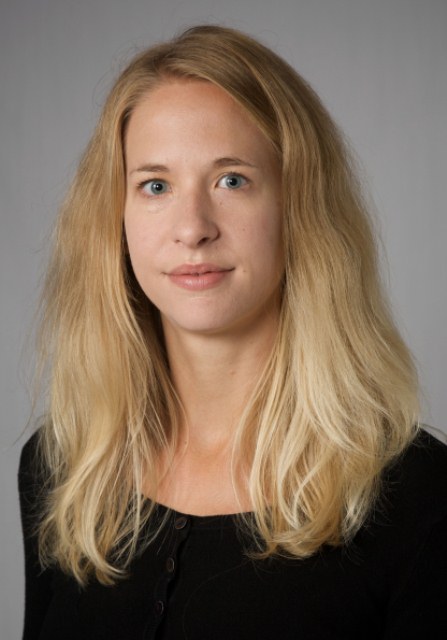by Gillian Ellis


At MTD we speak with pride of our bustling halls where dancers, actors, and musicians rub shoulders and are constantly (and unavoidably) interacting. The close proximity they share is one of the department’s great strengths, facilitating, as it does, a kind of intuitive cross-fertilization of their various creative endeavors. At MTD, a little cross-disciplinary inspiration is as close as a walk through the Varner hallways.
It can also be found in the classroom of Assistant Professor of Musicology Jessica Payette, who has an academic and personal interest in music, theatre and dance. And more.
Dr. Payette grew up in Minneapolis playing piano and taking ballet classes. She attended the University of Minnesota-Twin Cities, where she graduated with a BM in Piano Performance and a BA in Art History. She pursued a Ph.D. in musicology and the humanities at Stanford, and took ballet class throughout her years there. Her doctoral thesis focused on a staged piece, Schoenberg’s monodrama
Erwartung. So Jessica is probably as close as it’s possible to get to being an MTD all-rounder.
But of course, she has a specialty – twentieth century
avant-garde music, especially the work of Expressionist composer Arnold Schoenberg, which is famously atonal and “difficult.” Jessica says, “Many of my students, even graduate students, come to class with a prejudice against atonality and dissonance.” Asked if she wins over many converts, Dr. Payette acknowledged “some, not all.”
Discussing whether music that lacks a large following even among serious musicians can endure, Jessica says, “It lives on, for example, in film scores. It has become a cultural signifier for violence or trauma.” And she believes this explains, in part at least, why many listeners find it disturbing. “People often first experience this music paired with graphic images in the context of film or other dramatic productions and they understandably form negative associations. The music history and theory faculty endeavors to broaden students’ knowledge of atonal music, so that they realize that it is incredibly diverse and the preferred vocabulary of most of the world’s acclaimed living composers.”
Dr. Payette’s most recent research is also cross-disciplinary in nature. She is exploring the collaboration of dancers with contemporary composers, especially the professional relationship between Martha Graham and Louis Horst in the 1930s. The earliest modern dancers, like Isadora Duncan, turned away from the discipline of classical ballet technique while still using classical music. But Martha Graham, and other defectors from the Denishawn Dance Company which was led by dancers Ruth St. Denis and Ted Shawn, paired modern dance with modern music. It was a revolution.
Much of the primary source material that Jessica uses for this research is held in the archives of the New York Public Library and the San Francisco Performing Arts Library, where she accesses dance films, reviews, and unpublished scores, among other things.
Jessica is also interested in the emergence of ballet repertoire that combines traditional technique, with all the formal structure that implies, with experimental and world music, which does not typically utilize standard orchestration. And to illustrate how research can lead an academic down unexpected avenues, Dr. Payette says that studying the use of experimental music in ballet warrants some examination of labor politics, since the union contracts of orchestral musicians had to be modified as ballet music diversified.
Musicologists who focus on the great classical era or on early music, as Dr. David Kidger (MTD’s Western Music History Program Coordinator) does, also engage in cross-disciplinary research, but generally have fewer surviving documents that address the aesthetic goals of collaborative work. But Jessica says that such an approach is common for academics who study a vast array of twentieth-century topics, reflecting the abundance of collaborative work and detailed accounts of the process among the artists of that period – like Graham, Horst, and Isamu Noguchi (a sculptor whom Graham converted into a set designer).
Dr. Payette teaches both undergrad and graduate classes. She continues her research, prepared and able to follow wherever it leads her. She plays piano still, though only for her own pleasure, and while she no longer has time to fit the rigor of ballet into her schedule, she stays “in tune” with Pilates classes and running.
Hers is a life in music which is also filled with so much else that members of the MTD community are passionate about.
Listen to Erwartung here at the website of the Arnold Schönberg Center.
See Martha Graham dancing the role of Jocasta in Night Journey (score by William Schuman)
See ballet choreography by Antony Tudor set to Teiji Itō’s experimental music.


 At MTD we speak with pride of our bustling halls where dancers, actors, and musicians rub shoulders and are constantly (and unavoidably) interacting. The close proximity they share is one of the department’s great strengths, facilitating, as it does, a kind of intuitive cross-fertilization of their various creative endeavors. At MTD, a little cross-disciplinary inspiration is as close as a walk through the Varner hallways.
At MTD we speak with pride of our bustling halls where dancers, actors, and musicians rub shoulders and are constantly (and unavoidably) interacting. The close proximity they share is one of the department’s great strengths, facilitating, as it does, a kind of intuitive cross-fertilization of their various creative endeavors. At MTD, a little cross-disciplinary inspiration is as close as a walk through the Varner hallways.